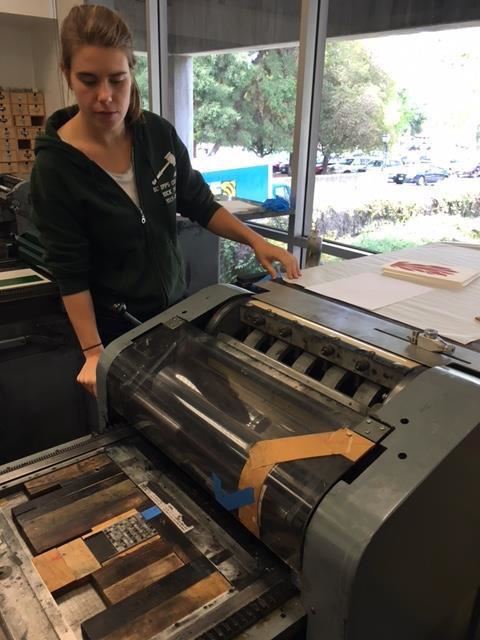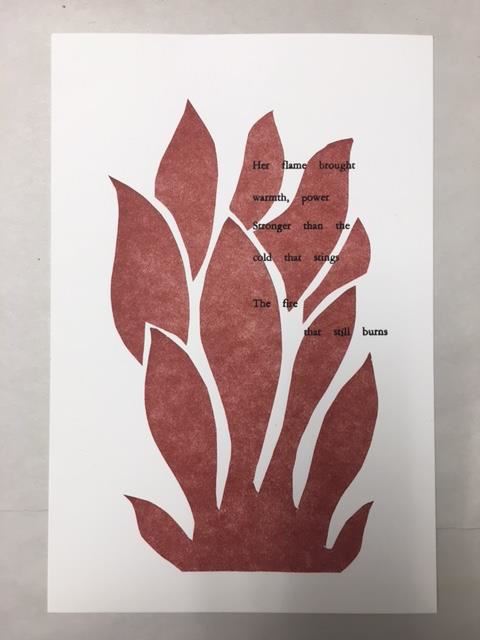
 Student: Grace Reckers
Student: Grace Reckers
1. Did any of the artists' books inspire you to create?
The book that Mason chose, “Body and Text,” inspired me to create a similar sort of piece with overlapping images with words, particularly evoking physical sensations, emotion, and body. This piece played a role in my decision to overlay text on colorful figures in my broadside that I worked on for my final project. I was also inspired by Clarissa Sligh’s “What’s Happening with Momma?” in which she discusses some intense personal experiences that brought her to where she is now. My piece was a memorial to Tatissa, who passed away this semester and who I was friends with. I depicted red flames with a short poem about Tatissa’s strength and warmth, using fire imagery to describe her tenacity and wide-ranging influence.
2. Which piece did you have the strongest reaction to? Why?
I had the strongest reaction to the Clarissa Sligh books because they were so deeply personal and emotional, and they were particularly about the experience of growing up as a black woman in the United States. Not only were Sligh’s pieces incredibly moving, but they also clearly demonstrated how one’s race and class shapes nearly all aspects of life, and while I was not able to connect with her work as strongly as a middle class white girl, Sligh’s artist books made the struggles painfully clear and easily evoked sympathy from readers. These narratives were particularly important while I was crafting my broadside memorial to Tatissa, as she existed on similar planes of oppression.
3. Did seeing any of the work trigger thoughts/memories of experiences/events that have impacted you? Please explain.
On a slightly lighter note, I really enjoyed the artist book “Ya Viene la Banda” by Gloria Morales that was in the Expanded Conversations exhibit. The way some of the outer panels were cut out to allow for a small opening to view the Mariachi band inside was very creative and drew me in, as the act of getting close enough to the book to actually see the tiny figures inside made me feel closer to the action. While I am not of Mexican heritage, the colors, imagery, and symbols represented in that book evoked memories of time spent backpacking through Mexico and other parts of Latin America for several months last summer. I really enjoyed the way that the piece engaged the audience by requiring that they be physically close to it to see what was going on, and that it had multi-dimensional cutouts of people that brought more life and complexity to the whole experience of “Ya Viene la Banda.”
4. How has the class broadened or challenged your perspective of race and identity?
My perspective of race and identity has been expanded thanks to all the different narratives I had the chance to read about through this class. While I feel like most classes (particularly in literature or other humanities) present race and identity as some universal struggle that can be generalized for people of similar racial or ethnic backgrounds, the exhibits that our class contributed to made it clear that many voices from seemingly similar backgrounds can have very different things to say about their experiences with race and other forms of identities. There were some books that spoke about living as a black person in the United States in terms of their encounters with institutionalized racism and how that pervades every opportunity and interaction they have, while others looked at the family structure and spoke to race and identity by discussing how their own family ties have formed and looking at bonds that have grown out of the struggle. Overall, I thought that the Of Color exhibit and Expanded Conversations both captured new perspectives on what it means to be racially oppressed that I had not had the chance to understand, much of which was thanks to these perspectives being presented in an easily accessible and relatable way.
5. What is your take away from the class? What will you remember 10 years from now?
Likely my greatest takeaway is that no single form of racial or identity oppression can be captured by one story alone. As I said before, the important part of this class and of the exhibits we worked on was getting to see how many different ways people will experience their race and will be impacted by similar forms of marginalization. Some of the most important moments in class came from seeing how people connected intense emotional experiences with colorful artistic representations of everyday objects or figures that suddenly brought about a whole new meaning with the text the author included. By leading the audience on in a particular way, the artist book authors are able to bring out powerful emotional responses that make their experiences much more relatable. A big takeaway from making the books themselves has come from seeing how effectively the authors have been able to tie together emotion and artistic representation, an important skill that I would like to work on in future creative projects.

Grace Reckers, “The Fire that Burns,” Of Color: Race & Identity in Artists' Books




